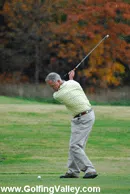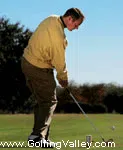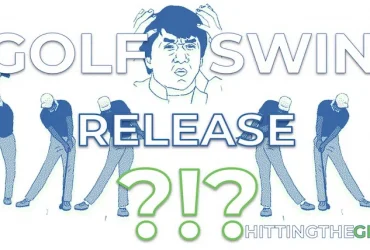Golf Swing Tips
Contents
- 1 How Can I Improve My Golf Swing?
- 1.1 Tip 1: Choose the correct Golf Club
- 1.2 Tip 2: It’s not all about your arms
- 1.3 Tip 3: It’s all about coiling up your body
- 1.4 Tip 4: Don’t be hasty!
- 1.5 Tip 5: Use the “waiters” arm position
- 1.6 Tip 6: Don’t grip the Golf Club too tightly!
- 1.7 Tip 7: Try hitting the side of the golf ball
- 1.8 Tip 8: The finishing swing position
- 1.9 Tip 9: Remember; Patience is a Virtue
- 1.10 Tip 10: Give Your Elbow The Elbow
- 1.11 Tip 11: Power From The Body
How Can I Improve My Golf Swing?
 Often the problem with a person’s swing is there ability to over-complicate the golf swing tips they have seen before. Because there are so many golf swing tips around these days, people often try to implement them all in one swing, and it’s just not possible.The tips I have outlined below are the key tips that myself and thousands of golfers before you have successfully implemented to improve their swing to the point of consistent distance and accuracy, which is what you want right? Just read on to improve your golf swing.
Often the problem with a person’s swing is there ability to over-complicate the golf swing tips they have seen before. Because there are so many golf swing tips around these days, people often try to implement them all in one swing, and it’s just not possible.The tips I have outlined below are the key tips that myself and thousands of golfers before you have successfully implemented to improve their swing to the point of consistent distance and accuracy, which is what you want right? Just read on to improve your golf swing.
Tip 1: Choose the correct Golf Club
One of the most helpful tips to remember is that just because you hit a ball harder does not mean it will travel a further distance. In fact, the harder you swing golf clubs at the ball, the more difficult it is to keep the ball in play. First of all, the harder you swing the club at the golf ball, the more off balance your body will be as a result of the harder down swing.
Secondly, you will start to develop an inconsistent swing throughout your round, making it very difficult to maintain and repeat the good swings. To make the game easier, take a four-iron instead of a five-iron or a three-wood instead of a five-wood and so on. By making a nice smooth swing with one extra club, your shots will feel solid and ultimately yield much better results. All you need to remember is that straight is always far.
Want some advice on buying the right golf clubs for you? Check out the best golf clubs for high handicappers article for some free advice.
Tip 2: It’s not all about your arms
Don’t think about your arms and swinging the golf club backwards. Try to think of the back swing as turning your back to the target. Don’t think of swinging the golf club up into the air. Instead think of just putting the golf club behind your back. It like the backswing is you winding up a spring, before you release.
Tip 3: It’s all about coiling up your body
To perform an efficient back swing, it’s all about coiling up your body while creating muscle tension or torque needed to release a powerful downswing. This perfected, will mean an excellent downswing technique and ultimately will lead to a more accurate direction on the golf ball. Also remember that resistance is created between the turning of the upper body and shoulders and the lesser turning of the hips and lower body.
Tip 4: Don’t be hasty!
For the backswing, you must not be in a hurry. A hurried backswing doesn’t make the downswing any faster. It may in fact be the opposite. You must remember that somewhere at the top of that backswing, you have to stop at the top of the backswing of the golf club and change and go the exact opposite direction into the downswing.
The speed of the backswing should be at a steady rate, not real fast or real slow. The tendency is to go too fast. Any time my golf swing begins to break down; the first correction is usually to slow down your backswing and relax and take your time.
Tip 5: Use the “waiters” arm position
In order to make sure that your right elbow is in the correct position at the top of your backswing, imagine that you are carrying a tray like a waiter would with a drink on it. Your top of the backswing position and the “waiter’s” arm position should be exactly the same.
This will make sure your right elbow is in the correct position and will also make sure that the golf club is swinging on the right swing plane with the proper clubface angle. If you remember this tip while on the golf course, it will mean you are on the way to a perfect golf swing!
Tip 6: Don’t grip the Golf Club too tightly!
We all know that in most exercising activities it pays to hold on very tightly — lifting weights or hanging from a trapeze.
But in golf, you don’t want to grip the club too tightly. Grip pressure is a big factor in your golf swing and one that’s often overlooked. If you grip the club with a death lock, chances are you won’t allow the club to properly release. That not only robs you of power, but it also prevents the club from squaring up at impact, causing all sorts of directional problems.
There are lots of good analogies you can use to help get an idea of the right amount of grip pressure. Holding a baby bird or holding a tube of toothpaste without squeezing out any paste are a couple I like. If you were to try to quantify it on a scale of one to 10,think of 10 as being as tight as you can hold the club and one as just barely hanging onto the club. You want to hold the club with a grip pressure of about four. That will give you a solid connection to the club and still allow you to swing properly.

Tip 7: Try hitting the side of the golf ball
It’s very common to see most golfers trying to hit the centre of the golf ball when hitting full shots. It is easy to understand why they do it because it makes sense to hit the ball in the middle if you want to make it fly straight; however in reality, excellent full shots actually strike the ball on the inside quadrant of the ball, not the centre.
The ideal swing path is elliptical (egg shaped). When the golfer hits a fine shot, the golf club hits the inside quadrant of the golf ball and the face is actually in a slightly open position. This is not noticed by the golfer. The golf ball and the clubface stay connected for a brief second of time. When the golf ball separates from the clubface, the face has rotated to a square position. The face continues to rotate and thus the ball flies relatively straight with a slight draw spin (right to left for right-handed players). Slices occur when players hit the outside of the ball, and the clubface and the ball separate in an open position. Use a plastic range bucket or a second ball to learn how to hit the ball on the inside quadrant. You will hit powerful shots which will end up down the middle when you strike the ball on the inside quadrant.
Tip 8: The finishing swing position
One of the best finishing tips for a great golf swing is after you swing the club, your finishing position should be where your weight is balanced on your front hip, your back toe firmly paced on the ground, your hands and forearms should be up above your front shoulder while your chest and back knee should be facing the hole or where you need the ball to go. If any of these things are not happening to you, then you need to correct your position and practice swinging and ending up in the proper finishing position. By working on your stance and finishing position, your golf swing is on its way to giving you a perfect game.
Tip 9: Remember; Patience is a Virtue
One of the main phenomena in people’s attitude toward golfing is that many expect to see fast improvement in play after the shortest length of time. A lot of the same people would not even raise an eyebrow or bat an eyelid at the length of time it takes to learn to play an instrument or to sing a certain song. The thing is most people forget that anybody can sing that song or play that instrument, but not anybody can do it to the level where you become famous for your style.
Golf is all about learning a technique or art that may take years to master just like an instrument. You cannot expect to know how to hit golf shots like Tiger Woods overnight! However, you can do it reasonably well in say, 6 months if done correctly. If you have been playing golf for a very long time and are still shooting in the mid 80s or 90s, you must realize that you are doing something in your golf swings wrong.
If you can recognize an incorrect golf swing on your part, then that is the first step to playing the best golf in your life. If you decide to change your swing technique, it will feel as if you are learning to swing all over again. This is only temporary as you will initially hit some very poor shots but will get the hang of the new golf swing and be on your way to better, more accurate golf shots.
Always try to remain optimistic and keep in mind you are only getting rid of a bad golf swing habit…from here on in the future of your golfing will be very bright indeed. Also, never expect to learn your new technique by yourself, this is impossible. Try to get a professional to stand and watch you and tell you how to do it as you will learn faster this way and won’t get bored as quickly. Make sure you practice what the instructor teaches you, this is extremely important. Do this in your own time as well as with the instructor. And above all, be patient!
Tip 10: Give Your Elbow The Elbow
A lot of successful players on the professional tour are seen to swing with their elbows flying out, and some of them swing with their elbows tucked in, both of which are proven to be successful. But which is the best golf swing technique to use? Well, many people who have studied the biomechanics of the golf swing have seen that people who have a flying elbow in their golf swing tend to see a fade of their balls flight. However, people who tend to keep their elbows in on a golf swing tend to see a draw.
Now….those of you who struggle with their slice or want to see a power hungry draw, the elbow position could be the solution, or the problem for that matter. When you let your trailing elbow fly out has the tendency to raise the trailing shoulder, which leads to all hell breaking loose on your shots.
The key for a good full golf swing is to erase the awkward shoulder tilt and the trailing elbow position at the top of the golf swing. The best position for the trailing elbow for getting rid of slices and promoting a draw is just on the inside of the seam running down the right side of your t-shirt. Because the elbow is placed in this position it allows the shoulders to turn on a level axis with the spine, which allows the club to come down on the inside of the downswing and will therefore improve both your power and your control.
Tip 11: Power From The Body
Every good golfer knows that power comes from the body, not the arms. To learn to power the club with your body instead of your arms and hands, put the club behind the ball at address, with your body in a dead-stop position. Without taking a backswing, try to drag the ball into the air. If you’re a player who uses his or her hands to control the club, you’ll probably struggle at first. However, you’ll quickly find that once you start moving the club with your body, you’ll begin to get the ball in the air more consistently. This helps you turn fully through the ball on the downswing.



